In today's competitive job market, selecting the right candidate for your testing team can be a daunting task. Asking insightful TestNG questions during interviews can help you evaluate a candidate's technical expertise and problem-solving skills accurately.
This blog post is a detailed guide featuring carefully curated TestNG interview questions divided into categories: general, junior-level, intermediate, automation frameworks, and test configurations. Whether you are interviewing a novice or an experienced tester, you'll find questions tailored to various expertise levels.
By using these questions, you can streamline your interview process and ensure you're hiring the right talent for your team. For a more comprehensive assessment, consider pre-screening candidates with our Selenium online test before the interview.
Table of contents
8 general TestNG interview questions and answers
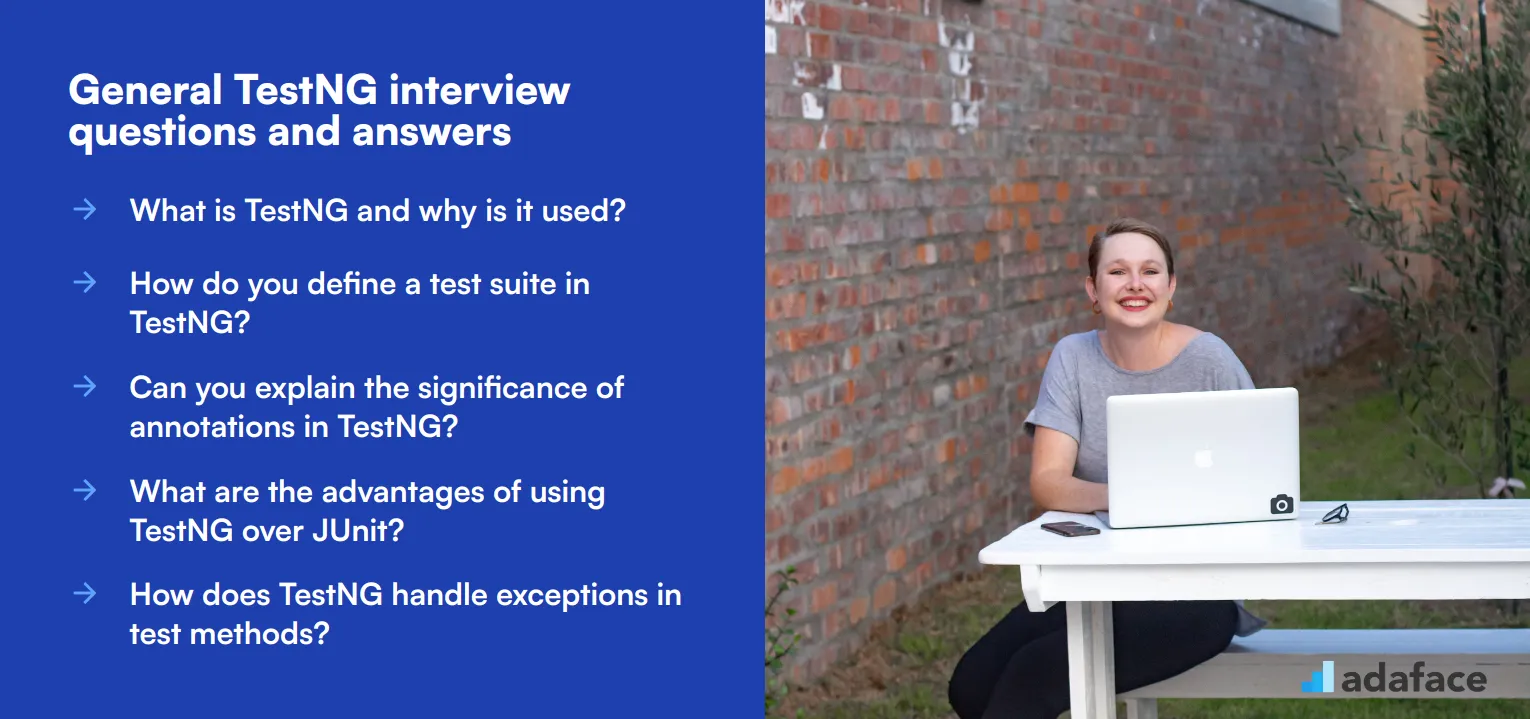
To make sure your candidates have a solid grasp of TestNG fundamentals, dive into these 8 general TestNG interview questions. Perfect for any recruiter or hiring manager, this list helps you uncover whether a candidate’s skills are up to the mark without getting lost in technical jargon.
1. What is TestNG and why is it used?
TestNG is a testing framework inspired by JUnit and NUnit but introduces new functionalities that make it more powerful and easier to use. Its key features include annotations, the ability to run tests in parallel, and the ability to configure the execution of test cases.
Candidates should articulate that TestNG helps in automating tests and managing test configurations more efficiently. Look for an understanding of why TestNG’s features make it a superior choice compared to other frameworks.
2. How do you define a test suite in TestNG?
In TestNG, a test suite is defined in an XML file (typically named testng.xml) which allows you to group and run multiple test classes or methods together. This file can include details on how tests should be prioritized, run in parallel, or configured.
Candidates should highlight their experience in configuring testng.xml to manage their testing processes effectively. An ideal response would also touch on how this setup helps in large-scale test management.
3. Can you explain the significance of annotations in TestNG?
Annotations in TestNG are used to control the execution of tests, setup/teardown operations, and manage configurations. Common annotations include @Test, @BeforeMethod, @AfterMethod, @BeforeClass, and @AfterClass.
Look for candidates who can explain how these annotations make the test code more readable and maintainable. An ideal candidate should be comfortable discussing how they’ve used these annotations in real-world scenarios.
4. What are the advantages of using TestNG over JUnit?
TestNG offers several enhancements over JUnit, such as better test configuration, the ability to run tests in parallel, dependency testing, and a more flexible execution model. It also supports data-driven testing through @DataProvider.
Candidates should focus on specific features that make TestNG more efficient for complex test scenarios. They should also mention any personal experiences where TestNG provided a clear advantage over JUnit.
5. How does TestNG handle exceptions in test methods?
TestNG allows you to specify expected exceptions in a test method using the 'expectedExceptions' attribute in the @Test annotation. This feature is useful for testing scenarios where exceptions are anticipated.
Candidates should explain how they’ve used this feature to validate error handling in their applications. An ideal response would also touch on the importance of verifying that the correct exceptions are thrown under specific conditions.
6. What is the purpose of the @DataProvider annotation in TestNG?
The @DataProvider annotation is used to create a method that returns data sets to be used by test methods. This allows for parameterized tests, where the same test method is run multiple times with different input values.
Look for candidates who can discuss how they’ve implemented data-driven testing using @DataProvider. They should be able to explain why this feature is beneficial for testing multiple input scenarios efficiently.
7. Can you explain how TestNG supports parallel test execution?
TestNG allows the execution of tests in parallel using the 'parallel' attribute in the testng.xml file. This can be configured at the suite, test, or method level, enabling faster test execution and better resource utilization.
Candidates should discuss their experience in setting up and managing parallel test execution. They should highlight the benefits, such as reduced test execution time and more efficient use of resources.
8. What strategies do you use to manage dependencies between tests in TestNG?
TestNG provides the 'dependsOnMethods' and 'dependsOnGroups' attributes in the @Test annotation to manage test dependencies. This ensures that dependent tests are only run if the tests they depend on pass successfully.
Candidates should explain how they’ve used these features to create robust test suites. Look for an understanding of the importance of managing test dependencies to avoid false positives and ensure accurate results.
21 TestNG interview questions to ask junior testers
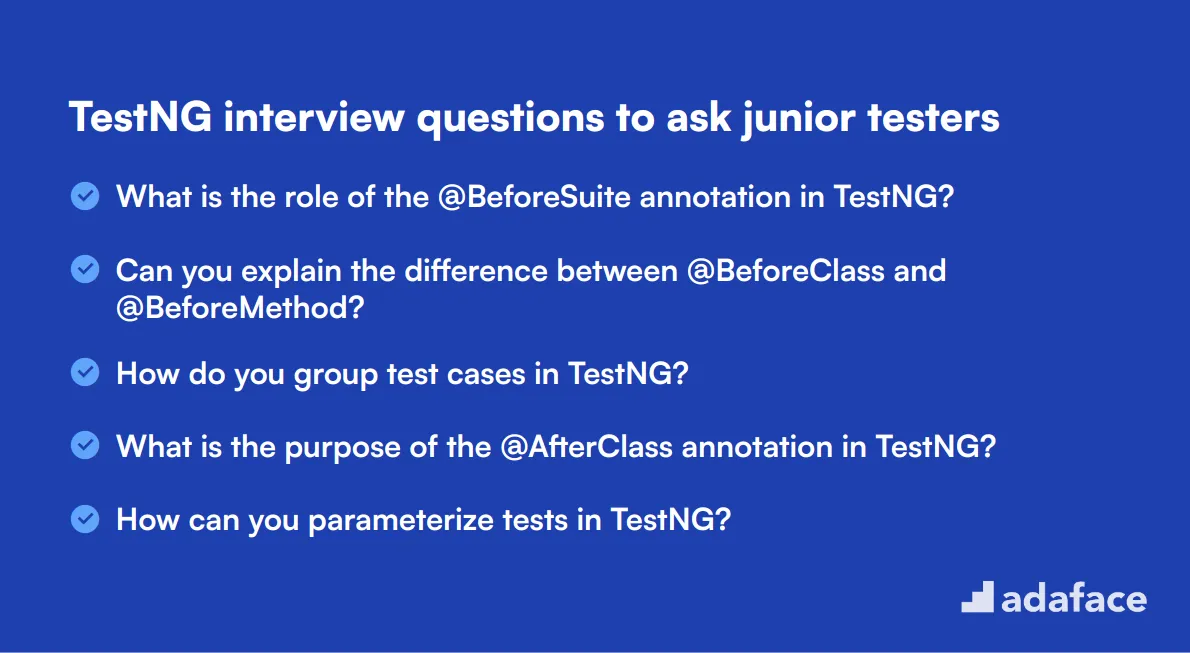
To effectively assess the foundational knowledge of junior testers in TestNG, consider asking these targeted questions during the interview. They will help you gauge not only the candidates' understanding of testing frameworks but also their practical skills relevant to the role, such as a software tester or a test engineer.
- What is the role of the @BeforeSuite annotation in TestNG?
- Can you explain the difference between @BeforeClass and @BeforeMethod?
- How do you group test cases in TestNG?
- What is the purpose of the @AfterClass annotation in TestNG?
- How can you parameterize tests in TestNG?
- What is the role of the testng.xml file?
- How would you skip a test method in TestNG?
- What are the different ways to report test results in TestNG?
- Can you describe the use of listeners in TestNG?
- How do you manage timeouts for test methods in TestNG?
- What is the significance of the @AfterMethod annotation?
- How can you run specific groups of tests from the command line?
- Can you explain the feature of test prioritization in TestNG?
- What is the impact of the test order on test results?
- How do you integrate TestNG with Maven?
- What are the ways to retrieve test parameters in TestNG?
- How do you handle dependency tests in TestNG?
- Can you explain how to use the @Listeners annotation?
- What strategies can you use to organize your test cases in TestNG?
- How can you implement custom reporting in TestNG?
- What are some common pitfalls when using TestNG?
10 intermediate TestNG interview questions and answers to ask mid-tier testers
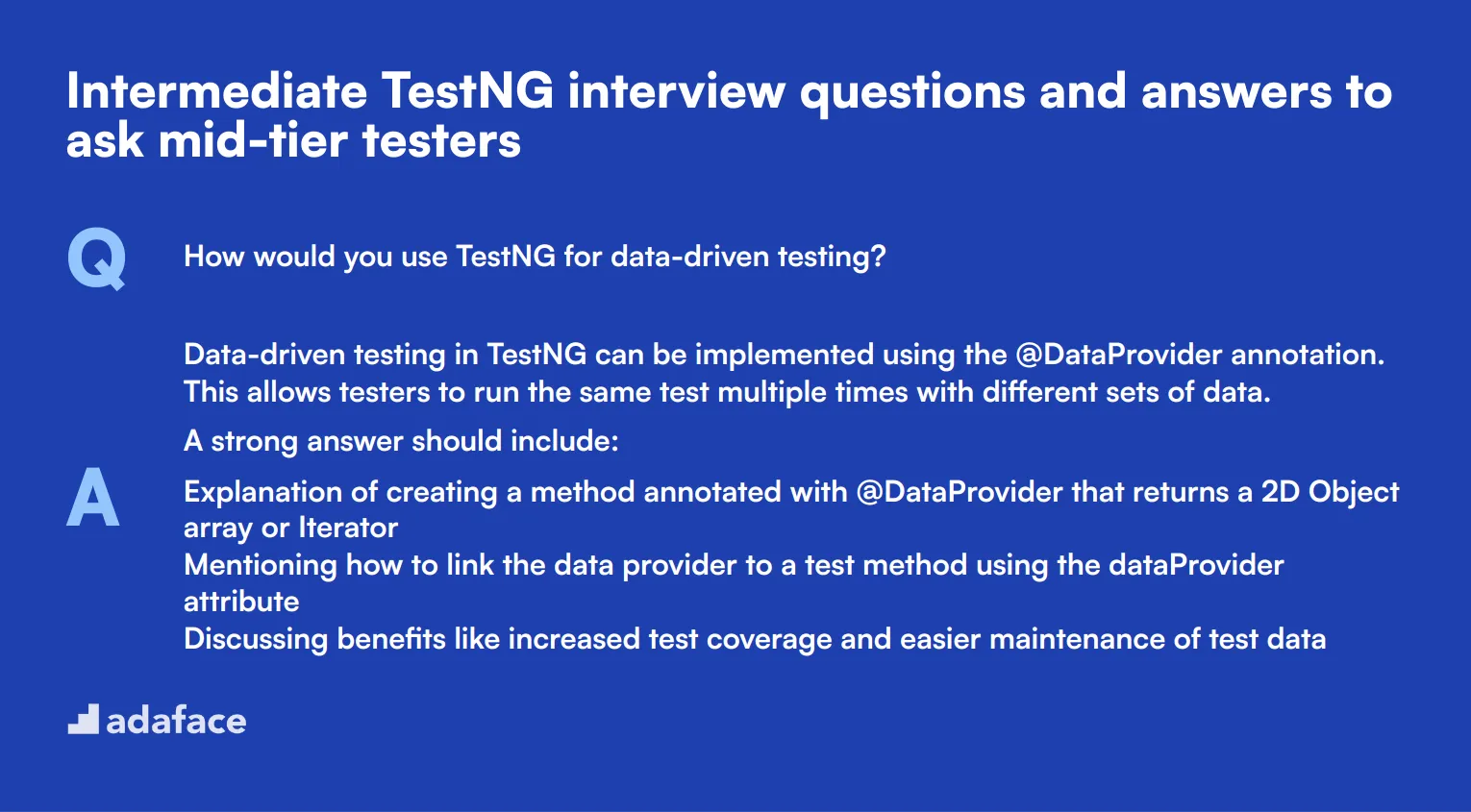
Ready to level up your TestNG interviews? These 10 intermediate questions are perfect for assessing mid-tier testers. They'll help you gauge a candidate's deeper understanding of TestNG features and best practices. Use these questions to spark insightful discussions and uncover how well applicants can apply TestNG in real-world testing scenarios.
1. How would you use TestNG for data-driven testing?
Data-driven testing in TestNG can be implemented using the @DataProvider annotation. This allows testers to run the same test multiple times with different sets of data.
A strong answer should include:
- Explanation of creating a method annotated with @DataProvider that returns a 2D Object array or Iterator
- Mentioning how to link the data provider to a test method using the dataProvider attribute
- Discussing benefits like increased test coverage and easier maintenance of test data
2. Can you explain the concept of soft assertions in TestNG?
Soft assertions in TestNG allow multiple assertions to be checked without stopping the test execution if one fails. This is useful when you want to collect all failures in a test rather than stopping at the first one.
A comprehensive answer should cover:
- How to use SoftAssert class from TestNG
- The importance of calling softAssert.assertAll() at the end of the test
- Comparing soft assertions with hard assertions (default assert statements)
- Scenarios where soft assertions are particularly useful, such as in UI testing
3. How do you handle cross-browser testing using TestNG?
Cross-browser testing in TestNG can be achieved by parameterizing the tests and using the @Parameters annotation. This allows the same test to be run on different browsers.
Look for answers that include:
- Explanation of how to set up browser parameters in the testng.xml file
- Using @Parameters annotation to inject browser information into the test method
- Discussion on implementing a WebDriver factory to create appropriate browser instances
- Mentioning the benefits of this approach for maintaining a single test script for multiple browsers
4. What strategies do you use for test data management in TestNG?
Effective test data management in TestNG is crucial for maintaining clean and efficient test suites. There are several strategies that can be employed.
A good answer might include:
- Using @DataProvider for supplying test data
- Leveraging external files (CSV, Excel, XML) for storing test data
- Implementing database connections for dynamic data retrieval
- Discussing the pros and cons of each approach and when to use them
- Mentioning the importance of data cleanup and reset between test runs
5. How would you implement retry logic for flaky tests in TestNG?
Implementing retry logic for flaky tests in TestNG can help reduce false negatives and increase test reliability. This can be achieved using TestNG's IRetryAnalyzer interface.
An ideal response should cover:
- Explanation of creating a custom retry analyzer by implementing IRetryAnalyzer
- How to set the retry limit and conditions for retry
- Applying the retry analyzer to specific tests or test classes
- Discussing when to use retry logic and potential drawbacks of overusing it
6. Can you explain how to implement custom reporting in TestNG?
Custom reporting in TestNG allows testers to generate reports tailored to specific project needs. This can be achieved by implementing TestNG listeners.
A comprehensive answer should include:
- Explanation of IReporter and ITestListener interfaces
- Steps to create a custom listener class implementing these interfaces
- How to register the custom listener (via XML or annotation)
- Discussion on what kind of information can be included in custom reports (e.g., test duration, environment details, screenshots)
- Mentioning the benefits of custom reporting for test analysis and stakeholder communication
7. How do you handle dependencies between test methods in TestNG?
TestNG provides mechanisms to manage dependencies between test methods, ensuring that tests run in the correct order and that dependent tests are skipped if prerequisite tests fail.
Look for answers that cover:
- Using the dependsOnMethods attribute to specify method dependencies
- Explaining the dependsOnGroups attribute for group-level dependencies
- Discussing the alwaysRun attribute for cases where a test should run regardless of dependency failures
- Mentioning potential pitfalls of overusing dependencies and how to maintain a balance
8. What approaches do you use for handling test environment setup and teardown in TestNG?
Proper test environment setup and teardown are crucial for maintaining test isolation and consistency. TestNG provides several annotations to manage this.
A strong answer should include:
- Explanation of @BeforeSuite, @BeforeTest, @BeforeClass, @BeforeMethod annotations for setup
- Corresponding @After... annotations for teardown
- Discussion on choosing the appropriate level of setup/teardown (method, class, test, or suite)
- Strategies for handling common resources and ensuring clean state between tests
- Mentioning the importance of efficient setup/teardown for test performance
9. How would you integrate TestNG with a Continuous Integration system?
Integrating TestNG with a Continuous Integration (CI) system is essential for automating the test execution process and providing quick feedback on code changes.
An ideal response should cover:
- Configuring the CI tool (e.g., Jenkins, GitLab CI) to run TestNG tests
- Using Maven or Gradle for build automation and dependency management
- Setting up test result reporting and integration with the CI dashboard
- Strategies for handling test failures in the CI pipeline
- Discussing the benefits of CI integration for improving software quality and team productivity
10. Can you explain how to implement multi-threading in TestNG?
Multi-threading in TestNG allows for parallel execution of tests, which can significantly reduce overall test execution time. TestNG provides built-in support for multi-threading.
Look for answers that include:
- Configuring parallel execution in testng.xml using the parallel attribute
- Explaining different parallel modes (methods, classes, tests)
- Discussion on thread-count and data-provider-thread-count attributes
- Strategies for making tests thread-safe
- Mentioning potential challenges of parallel execution and how to address them (e.g., race conditions, shared resources)
12 TestNG questions related to automation frameworks
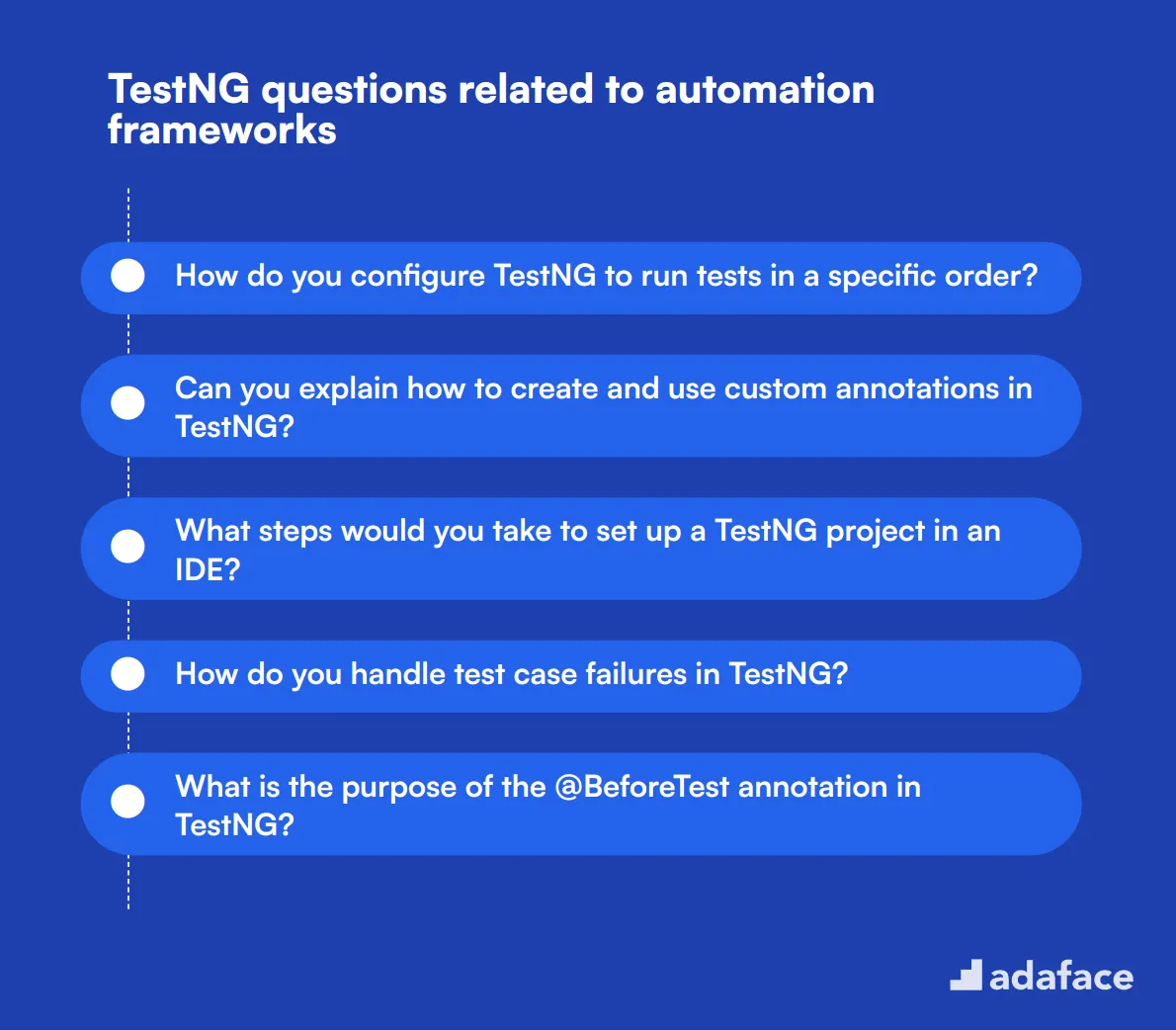
To evaluate candidates' expertise in utilizing TestNG within automation frameworks, consider these targeted questions. They will help you assess their technical knowledge and practical skills, ensuring they align with your team's needs. For more detailed insights, you can also refer to this test engineer job description.
- How do you configure TestNG to run tests in a specific order?
- Can you explain how to create and use custom annotations in TestNG?
- What steps would you take to set up a TestNG project in an IDE?
- How do you handle test case failures in TestNG?
- What is the purpose of the @BeforeTest annotation in TestNG?
- Can you describe the process to run TestNG tests in a specific environment?
- How do you integrate TestNG with reporting tools like ExtentReports?
- What are some best practices for writing maintainable test scripts in TestNG?
- How do you leverage the TestNG framework for API testing?
- Can you explain the concept of test dependencies and how to manage them in TestNG?
- What is the best way to handle version control for TestNG test cases?
- How do you ensure your TestNG tests are reusable and efficient?
7 TestNG interview questions and answers related to test configurations
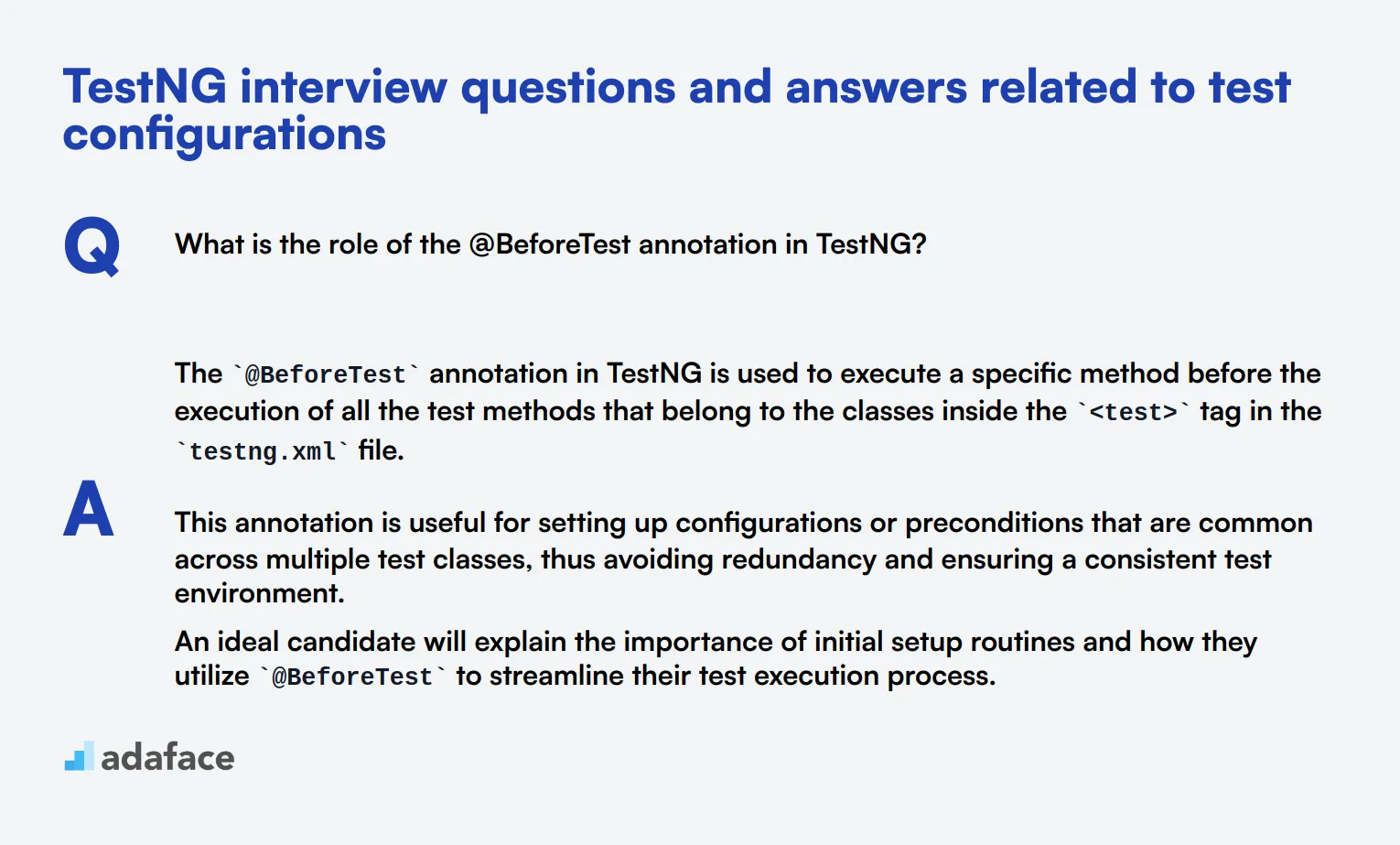
To ensure your candidates have a solid understanding of test configurations in TestNG, use these specific interview questions. They help gauge the depth of knowledge and practical application skills vital for effective test management and execution.
1. What is the role of the @BeforeTest annotation in TestNG?
The @BeforeTest annotation in TestNG is used to execute a specific method before the execution of all the test methods that belong to the classes inside the <test> tag in the testng.xml file.
This annotation is useful for setting up configurations or preconditions that are common across multiple test classes, thus avoiding redundancy and ensuring a consistent test environment.
An ideal candidate will explain the importance of initial setup routines and how they utilize @BeforeTest to streamline their test execution process.
2. How do you configure TestNG to run tests in a specific order?
To run tests in a specific order in TestNG, you can use the priority attribute of the @Test annotation. This attribute allows you to specify the order in which test methods should run by assigning them integer values.
Tests with lower priority values run before those with higher values. If multiple tests have the same priority, they will run in an arbitrary order. Additionally, defining the order of test classes in the testng.xml file can help manage execution order at a broader level.
Look for candidates who can clearly articulate the importance of test order and provide examples of when and why they would need to control this aspect of their testing strategy.
3. Can you explain the purpose of the @AfterTest annotation in TestNG?
The @AfterTest annotation in TestNG is used to execute a method after all the test methods that belong to the classes inside the <test> tag in the testng.xml file have run.
This is particularly useful for performing cleanup activities or resetting states that were modified during the test execution. It ensures that your test environment is left in a consistent state for future test runs or other processes.
Candidates should highlight their experience with post-test cleanup and why it's crucial for maintaining a reliable test environment.
4. What strategies can you use to organize your test cases in TestNG?
Organizing test cases in TestNG can be done using a combination of testng.xml configurations, groups, and packages. The testng.xml file allows you to define which classes and methods to run, while groups enable you to categorize and run subsets of tests as needed.
Using packages to structure your test classes can also help in maintaining a clean and logical organization. Additionally, incorporating descriptive naming conventions and comprehensive documentation can further enhance the clarity and manageability of your test suite.
An ideal candidate will demonstrate a methodical approach to organizing tests, ensuring both scalability and maintainability of the test suite.
5. How would you implement retry logic for flaky tests in TestNG?
Implementing retry logic for flaky tests in TestNG typically involves using the IRetryAnalyzer interface. This interface allows you to define conditions under which a failed test should be retried. You then associate this retry analyzer with your test methods using the retryAnalyzer attribute of the @Test annotation.
By implementing this interface, you can control the number of retries and the specific conditions that warrant a retry, thus improving the robustness of your test execution.
Candidates should discuss their experience with handling flaky tests and how implementing retry logic has helped them achieve more reliable test outcomes.
6. What is the best way to handle version control for TestNG test cases?
Handling version control for TestNG test cases involves using a version control system (VCS) like Git to manage your test scripts and configurations. This includes organizing test cases in a repository, using branches to manage different versions or features, and employing commit messages to document changes.
Integrating version control with your continuous integration (CI) pipeline can further enhance collaboration and ensure that test cases are automatically executed upon code changes.
Look for candidates who can articulate the benefits of using a VCS and provide examples of how they have managed test cases in their previous projects.
7. How do you ensure your TestNG tests are reusable and efficient?
Ensuring that TestNG tests are reusable and efficient involves several best practices. First, writing modular and independent test methods helps in reusability. Second, employing data-driven testing techniques using @DataProvider to allow the same test method to run with different data sets.
Additionally, using configuration annotations like @BeforeMethod and @AfterMethod to handle setup and teardown activities ensures that the tests remain focused and efficient. Proper organization of test suites and utilization of groups can also contribute to efficiency.
Ideal candidates will mention their experience with these practices and how they have applied them to maintain high-quality, reusable test cases.
Which TestNG skills should you evaluate during the interview phase?
While it's challenging to assess every aspect of a candidate's TestNG proficiency in a single interview, focusing on key skills can provide valuable insights. For TestNG interviews, certain core competencies are particularly important to evaluate.
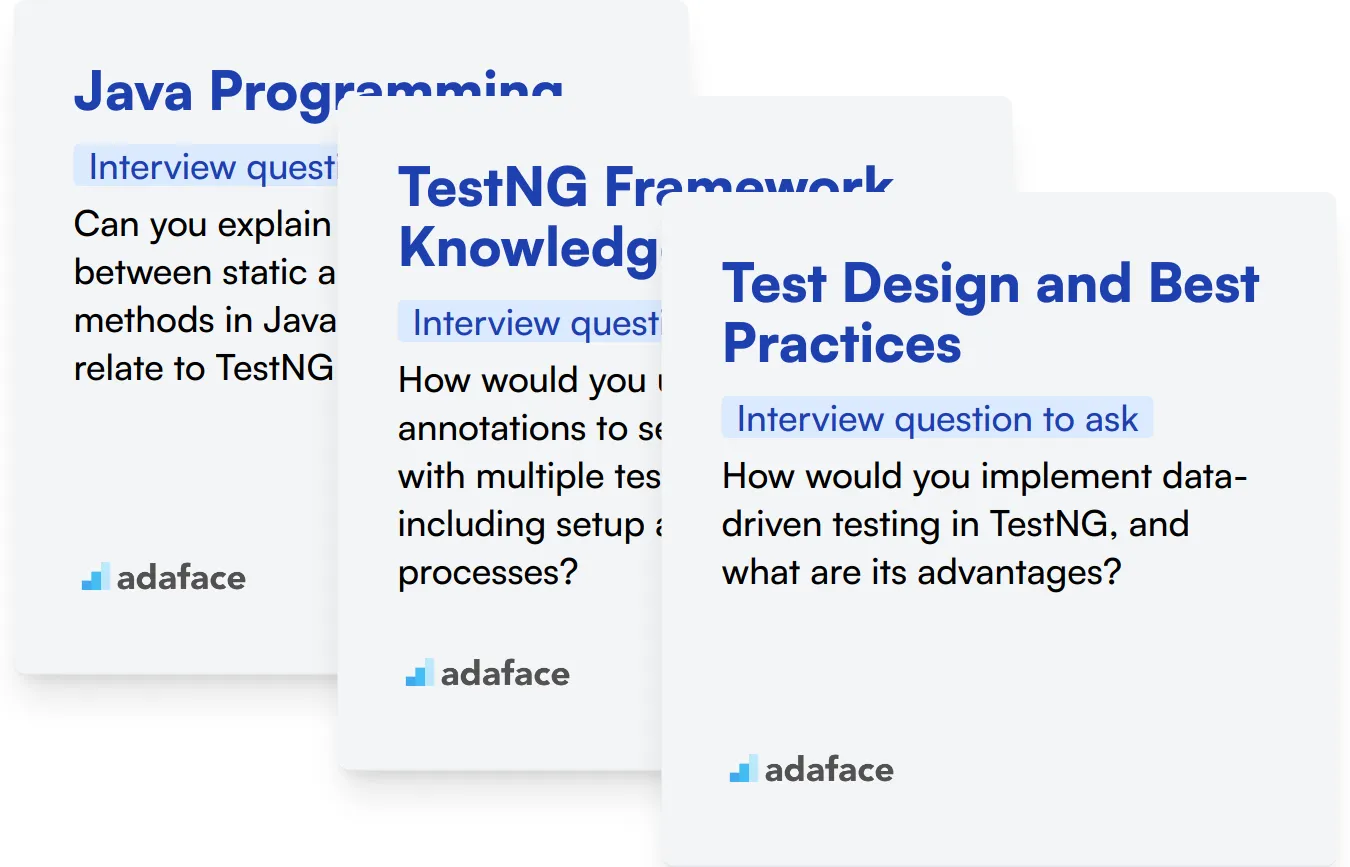
Java Programming
Java programming is the foundation for TestNG. A strong grasp of Java is necessary for writing effective TestNG tests and understanding the framework's capabilities.
To assess Java skills, consider using a Java online test that includes relevant multiple-choice questions. This can help filter candidates based on their Java proficiency.
During the interview, you can ask targeted questions to gauge the candidate's Java expertise. Here's an example:
Can you explain the difference between static and non-static methods in Java and how they relate to TestNG test methods?
Look for answers that demonstrate understanding of Java's static and non-static concepts, and how TestNG utilizes these in test method declarations. A good response should mention that TestNG test methods are typically non-static, allowing for instance-level setup and teardown.
TestNG Framework Knowledge
Understanding TestNG's core features and functionality is crucial. This includes knowledge of annotations, test configuration, and test execution flow.
To assess a candidate's TestNG framework knowledge, consider asking:
How would you use TestNG annotations to set up a test suite with multiple test methods, including setup and teardown processes?
A strong answer should mention annotations like @BeforeSuite, @BeforeTest, @BeforeMethod, @Test, @AfterMethod, @AfterTest, and @AfterSuite. The candidate should explain how these annotations control the flow of test execution and manage resources.
Test Design and Best Practices
Effective test design is key to creating maintainable and reliable TestNG tests. This skill encompasses understanding test isolation, data-driven testing, and test configuration.
To evaluate a candidate's test design skills, you might ask:
How would you implement data-driven testing in TestNG, and what are its advantages?
Look for answers that discuss using @DataProvider annotation, explaining how it allows for multiple test scenarios with different input data. The candidate should mention benefits like improved test coverage and easier test maintenance.
Find the best TestNG experts for your team with Adaface
When hiring candidates with TestNG skills, it is important to ensure they possess the necessary expertise. This requires an accurate assessment of their knowledge and practical abilities in using TestNG effectively.
The most accurate way to evaluate these skills is through skill tests. Consider utilizing our TestNG interview questions to assess candidates' capabilities before the interview process begins.
Once you conduct these tests, you'll be able to shortlist the best candidates for interviews. This will save you time and help you focus on applicants who meet your requirements.
To get started with your hiring process, visit our online assessment platform to explore relevant tests and sign up today.
Appium Android Online Test
Download TestNG interview questions template in multiple formats
TestNG Interview Questions FAQs
TestNG is a testing framework for Java that offers features for test organization, execution, and reporting. It's designed to cover various testing categories including unit, functional, and integration testing.
TestNG offers more flexibility in test configuration, better support for parameterized and data-driven testing, and improved annotation support compared to JUnit. It also provides built-in support for parallel execution and test grouping.
Key features include flexible test configuration, support for data-driven testing, powerful execution model, dependency testing, parallel execution, built-in reporting, and integration with various tools and IDEs.
To prepare, review TestNG concepts, practice writing test cases, understand annotations and configuration, familiarize yourself with TestNG XML files, and work on sample automation projects using TestNG.
Yes, TestNG is suitable for testers at all levels. Beginners can start with basic annotations and simple test cases, while experienced testers can leverage advanced features for complex testing scenarios and framework development.

40 min skill tests.
No trick questions.
Accurate shortlisting.
We make it easy for you to find the best candidates in your pipeline with a 40 min skills test.
Try for freeRelated posts
Free resources




